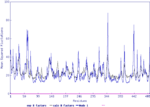Normal Mode Analysis of Glucocerebrosidase
Contents
Introduction
Elastic and Gaussian Network Models
WEBnm@
WEBnm@ is a web-server which provides automated computation and analysis of low-frequency normal modes of proteins. For an input structure file in PDB format, the normal modes are calculated and a series of automated calculations (normalized squared atomic displacements, vector field representation and an animation of the first six vibrational modes). Additional to the single analysis (calculating lowest frequency normal modes for one protein), the server offers a comperative analysis. In this analysis, the normal modes of a set of aligned sequences are calculated and compared. This feature is still under development. <ref>Hollup SM, Sælensminde G, Reuter N. WEBnm@: a web application for normal mode analysis of proteins BMC Bioinformatics. 2005 Mar 11;6(1):52 </ref>
Usage
- Webserver: http://apps.cbu.uib.no/webnma/home
- Input:
- Single Analysis: structure file in PDB format
- Comparative Analysis: structure files in PDB format and sequence files in fasta format
Results
Figure 1 to 5 show the first five vibrational modes (modes 7 to 11) calculated with WEBnm@ for the structure of glucocerebrosidase (2NTO). On the left side of each figure the vectors are shown, whereas the movement is illustrated to the right.
Discussion
ElNémo
ElNémo is a web-server based on the Elastic Network Model. The tool computes, visualizes and analyses low-frequency normal modes of large macro-molecules. Any size of proteins can be treated as ElNémo uses a 'rotation-translation-block' approximation. <ref>K. Suhre & Y.H. Sanejouand, ElNemo: a normal mode web-server for protein movement analysis and the generation of templates for molecular replacement. Nucleic Acids Research, 32, W610-W614, 2004. </ref>
Usage
- Webserver: http://www.igs.cnrs-mrs.fr/elnemo/start.html
- Input:
- structure file in PDB format
- supplementary options for NMA calculation (number of normal modes to be calculated, minimum and maximum perturbation and stepsize between DQMIN and DQMAX)
- options for computing the eigenmodes (NRBL and cutoff to identify elastic interactions)
Results
Figure 6 to 9 show for each of the five first vibrational normal modes calculated with ElNémo three different perspectives.
Discussion
Anisotropic Network Model
The ANM Webserver provides NMA Analysis with the anisotropic network model (ANM) which is an elastic network (EN) introduced in 2000. It is a very fast method which predicts the global modes. The ANM adopts a uniform force constant γ to all springs and nodes are refered as the Cα atoms.<ref>Anisotropic network model: systematic evaluation and a new web interface, Eyal E, Yang LW, Bahar I. Bioinformatics. 22, 2619-2627, (2006)</ref>
Usage
- Webserver: http://ignmtest.ccbb.pitt.edu/cgi-bin/anm/anm1.cgi
- Input:
- structure file in PDB format or PDB id and chain
- model
- cutoff for interaction between Cα atoms in Å
- distance weight for interaction between Cα atoms
Results
| Mode 1 | Mode 2 | Mode 3 | Mode 4 | Mode 5 | |||||
|---|---|---|---|---|---|---|---|---|---|
| Inter Distance Analysis | |||||||||
Overall energy: 27824.672768448 |
Overall energy: 42344.496142536 |
Overall energy: 43818.992771088 |
Overall energy: 85235.1119198879 |
Overall energy: 90925.846279128 | |||||
| B-factors/mode fluctuations | |||||||||
| Mode 6 | Mode 7 | Mode 8 | Mode 9 | Mode 10 | |||||
|---|---|---|---|---|---|---|---|---|---|
| Inter Distance Analysis | |||||||||
Overall energy: 107191.169783064 |
Overall energy: 112430.078797944 |
Overall energy: 138939.176046648 |
Overall energy: 156195.358655472 |
Overall energy: 154660.33882932 | |||||
| B-factors/mode fluctuations | |||||||||
Discussion
oGNM
NOMAD-Ref
Discussion
All-atom NMA
Comparison NMA / MD
References
<references/>







































